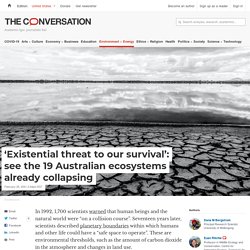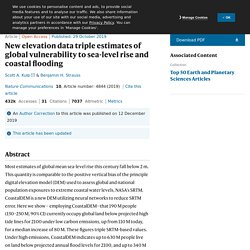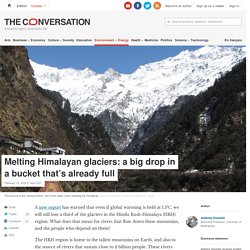

'Existential threat to our survival': see the 19 Australian ecosystems already collapsing. In 1992, 1,700 scientists warned that human beings and the natural world were “on a collision course”.

Seventeen years later, scientists described planetary boundaries within which humans and other life could have a “safe space to operate”. These are environmental thresholds, such as the amount of carbon dioxide in the atmosphere and changes in land use. Crossing such boundaries was considered a risk that would cause environmental changes so profound, they genuinely posed an existential threat to humanity. This grave reality is what our major research paper, published today, confronts. EOSDIS Worldview. Climate emergency declaration. Governments and government bodies must put in place effective measures within their powers with courage and responsibility.

The City Council is taking its own steps, but other government bodies must also assume their own responsibilities. The Port and the Airport are responsible for 12.86% of the CO2 emissions allocated to the city, as well as for a much higher carbon footprint than that attributable to the city. They therefore play a very significant role in putting a stop to the effects we are already experiencing.
This is also true for the Government of Catalonia, which must enforce the Catalan Climate Change Law, and for the Spanish Government, which must stop subsidising fossil fuels and start seriously promoting the move to renewable energies, among other urgent actions. New elevation data triple estimates of global vulnerability to sea-level rise and coastal flooding.
Global Given each sea level scenario analyzed (Supplementary Table 1), and alternately using SRTM and CoastalDEM, we estimate the number of people on land that may be exposed to coastal inundation—either by permanently falling below MHHW, or temporarily falling below the local annual flood height (Table 1, Supplementary Data 1).

Coastal defenses are not considered, but hydrologic connectivity to the ocean is otherwise enforced using connected components analysis. Figure 1 presents permanent inundation surfaces at select locations for median K17/RCP 8.5/2100. Future population growth and migration are also not considered; rather, we use 2010 (essentially current) population density data from Landscan13 to indicate threats relative to present development patterns.
Permanent inundation surfaces predicted by CoastalDEM and SRTM given the median K17/RCP 8.5/2100 sea-level projection. National CoastalDEM versus SRTM by country. Validation Sensitivity analysis. As the Arctic heats up, what’s in store for its food webs? The view from Kongsfjorden, Svalbard, is endless snow-covered mountains and glassy, frigid water.

You need to travel roughly 400 miles west from the remote Norwegian archipelago to reach the northeast coast of Greenland. Kongsfjorden, home to one of the few human settlements on Svalbard, has been studied intensively. It's a "natural laboratory" of Arctic climate change, one that has suggests that the ecosystems living in these icy water have so far managed a surprising amount of resilience in the face of rising temperatures, according to a paper in Nature Climate Change. But the long-term picture suggests a future that is probably not so rosy. Indigenous Weather Knowledge. Aboriginal and Torres Strait Islander people have developed an intricate understanding of the environment over many thousands of years.

Artist: Laurie Nilsen The artwork used in the design of this website represents the relationships between seasonal, meteorological and astronomical changes - and how the Mandandanji people read these changes to inform life on country. About the Indigenous Weather Knowledge website Learn more about the Indigenous Weather Knowledge (IWK) website and the Bureau of Meteorology's commitment to strengthening respectful and collaborative relationships with Aboriginal and Torres Strait Islander people. Sea Level Rise. The Weather Channel Flooded Charleston to Make You Care About Climate Change. Lost World. Melting Himalayan glaciers: a big drop in a bucket that's already full. A new report has warned that even if global warming is held at 1.5℃, we will still lose a third of the glaciers in the Hindu Kush-Himalaya (HKH) region.

What does that mean for rivers that flow down these mountains, and the people who depend on them? The HKH region is home to the tallest mountains on Earth, and also to the source of rivers that sustain close to 2 billion people. These rivers supply agriculture with water and with sediments that fertilise soils in valleys and the floodplain. Climate change is killing off Earth’s little creatures. Climate change gets blamed for a lot of things these days: inundating small islands, fueling catastrophic fires, amping-up hurricanes and smashing Arctic sea ice.

But a global review of insect research has found another casualty: 40% of insect species are declining and a third are endangered. It confirms what many have been suspecting: in Australia and around the world, arthropods – which include insects, spiders, centipedes and the like — appear to be in trouble. Read more: Curious Kids: why do spiders have hairy legs? The global review comes hard on the heels of research published in the Proceedings of the National Academy of Sciences USA that suggests a potent link between intensifying heat waves and stunning declines in the abundance of arthropods.
If that study’s findings are broadly valid – something still far from certain – it has chilling implications for global biodiversity. A global map of wind, weather, and ocean conditions. PolarGlobe.